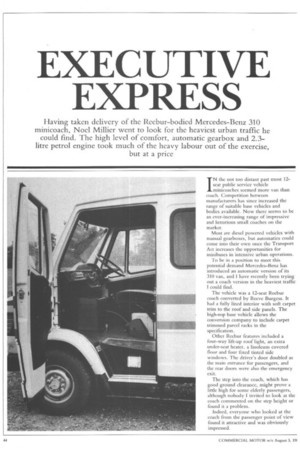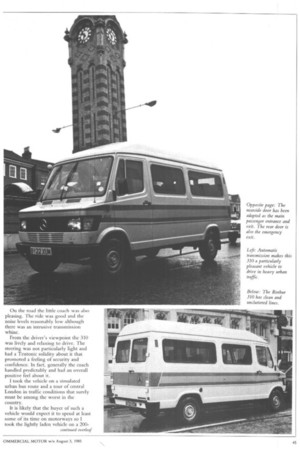ExECUTIVE EXPRESS
Page 48

Page 49

Page 50

If you've noticed an error in this article please click here to report it so we can fix it.
Having taken delivery of the Reebur-bodied Mercedes-Benz 310 minicoach, Noel Millier went to look for the heaviest urban traffic he could find. The high level of comfort, automatic gearbox and 2.3litre petrol engine took much of the heavy labour out of the exercise, but at a price IN the not too distant past most 12seat public service vehicle minicoaches seemed more van than coach. Competition between manufacturers has since increased the range of suitable base vehicles and bodies available. Now there seems to be an ever-increasing range of impressive and luxurious small coaches on the market.
Most are diesel powered vehicles with manual gearboxes, but automatics could conic into their own once the Transport Act increases the opportunities for minibuses in intensive urban operations.
To be in a position to meet this potential demand Mercedes-Benz has introduced an automatic version of its 310 van, and I have recently been trying out a coach version in the heaviest traffic I could find.
The vehicle was a 12-seat Reebur coach converted by Reeve Burgess. It had a fully lined interior with soft carpet trim to the roof and side panels. The high-top base vehicle allows the conversion.company to include carpet trimmed parcel racks in the specification.
Other Reebur features included a four-way lift-up roof light, an extra under-seat heater, a linoleum covered floor and four fixed tinted side
windows. The driver's door doubled as the main entrance for passengers, and the rear doors were also the emergency exit.
The step into the coach, which has good ground clearance, might prove a little high for some elderly passengers, although nobody I invited to look at the coach commented on the step height or found it a problem.
Indeed, everyone who looked at the coach from the passenger point of view found it attractive and was obviously impressed. On the road the little coach was also pleasing. The ride was good and the noise levels reasonably low although there was an intrusive transmission whine.
From the driver's viewpoint the 310 was lively and relaxing to drive. The steering was not particularly light and had a Teutonic solidity about it that promoted a feeling of security and confidence. In fact, generally the coach handled predictably and had an overall positive feel about it.
I took the vehicle on a simulated urban bus route and a tour of central London in traffic conditions that surely must be among the worst in the country.
It is likely that the buyer of such a vehicle would expect it to spend at least some of its time on motorways so I took the lightly laden vehicle on a 200 mile run on inotorways and A-roads also.
The automatic proved capable of sustained 112km/h(70mph) motorway cruising and was just as capable in the Cut and thrust of London driving. The four-speed automatic box has a floor mounted selection lever with gear hold positions for first, second, third and fourth gears. (A gear selection indicator is included on the facia.) In no driving conditions which I encountered did I feel it necessary to hold gears, however.
Unladen acceleration was particularly quick, with the coach capable of reaching 40mph in well under 10 seconds.
In spite of the coach's fine qualities, I found points to criticise, and I suspect it could prove fairly expensive to operate.
On the urban operation I found the coach returned 18.61it/100km (15.2mpg) an average speed of slightly less than 15rnph. On the motorway operation it returned 15.91it/100km (17.7mpg) at an average speed of around 50mph. It operated on two-star petrol.
The conversion was generally well finished, although there were some minor defects. For example, its decorative curtains kept coming off their runners, dropping plastic curtain rings all over the floor, and plastic caps on the seat mounting bolts seemed forever to be coming adrift and could easily be lost.
The coach was fitted with a radio and public address system, but the radio aerial seemed to be fitted in just the right place to pick up interference from the vehicle engine.
Niggles aside, the mini-coach could have many useful roles and a high earning potential.
It is manoeuvrable in traffic and the high driving position offers the driver very good visibility. The load platform on the rear-wheel drive van is high enough to provide passengers on this coach version a good view over hedges and above the level of car-bound people Luggage space on the vehicle is limited to any space passengers can find under the seats or on the parcel racks, so it would not be a suitable coach for extended touring. I could find no objection to its use on longer day tours, however.
From the daily maintenance point of view the minicoach should present few problems. Daily checks can be carried out from outside, but for more major maintenance or repairs to the engine and battery, which is fitted under the drivers' seat, fitters will have to work inside the vehicle and take great care not to damage the soft trim.
Priced at £15,3410 retail, excluding vat, the Mercedes-Benz petrol automatic 310 coach could well find favour among operators looking for an up-market way to carry up to 12 people — particularly in heavy urban traffic conditions.






















































































